Blood Biomarkers of Recovery Efficiency in Soccer Players
Abstract
1. Introduction
2. Materials and Methods
2.1. Study Design
2.2. Participants
2.3. Blood Sampling
2.4. Biochemical Analyses
2.5. Statistical Analyses
3. Results
3.1. Anthropometric Parameters
3.2. Comparison of Groups in Terms of Selected Blood Biomarkers
3.3. Variance of Selected Blood Biomarkers in Time
3.4. Correlations between Cumulative Competitive Match-Time and Biochemical Variables
4. Discussion
5. Conclusions
Author Contributions
Funding
Acknowledgments
Conflicts of Interest
References
- Fallon, K.E. The clinical utility of screening of biochemical parameters in elite athletes: Analysis of 100 cases. Br. J. Sports Med. 2008, 42, 334–337. [Google Scholar] [CrossRef]
- Warren, J.D.; Blumbergs, P.C.; Thompson, P.D. Rhabdomyolysis: A review. Muscle Nerve 2002, 25, 332–347. [Google Scholar] [CrossRef]
- Brancaccio, P.; Maffulli, N.; Limongelli, F.M. Creatine kinase monitoring in sport medicine. Br. Med. Bull. 2007, 81, 209–230. [Google Scholar] [CrossRef]
- Mokuno, K.; Riku, S.; Sugimura, K.; Takahashi, A.; Kato, K.; Osugi, S. Serum creatine kinase isoenzymes in duchenne muscular dystrophy determined by sensitive enzyme immunoassay methods. Muscle Nerve 1987, 10, 459–463. [Google Scholar] [CrossRef]
- Noakes, T.D. Effect of Exercise on Serum Enzyme Activities in Humans. Sport Med. 1987, 4, 245–267. [Google Scholar] [CrossRef]
- Nédélec, M.; McCall, A.; Carling, C.; Legall, F.; Berthoin, S.; Dupont, G. Recovery in Soccer. Sport Med. 2012, 42, 997–1015. [Google Scholar] [CrossRef]
- Banfi, G.; Del Fabbro, M. Relation between serum creatinine and body mass index in elite athletes of different sport disciplines. Br. J. Sports Med. 2006, 40, 675–678. [Google Scholar] [CrossRef]
- Cazzola, R.; Russo-Volpe, S.; Cervato, G.; Cestaro, B. Biochemical assessments of oxidative stress, erythrocyte membrane fluidity and antioxidant status in professional soccer players and sedentary controls. Eur J. Clin. Investig. 2003, 33, 924–930. [Google Scholar] [CrossRef]
- Fallon, K.E.; Sivyer, G.; Sivyer, K.; Dare, A. The biochemistry of runners in a 1600 km ultramarathon. Br. J. Sports Med. 1999, 33, 264–269. [Google Scholar] [CrossRef]
- Leers, M.P.G.; Schepers, R.; Baumgarten, R. Effects of a long-distance run on cardiac markers in healthy athletes. Clin. Chem. Lab. Med. 2006, 44, 999–1003. [Google Scholar] [CrossRef]
- Manna, I.; Khanna, G.L.; Chandra Dhara, P. Effect of training on physiological and biochemical variables of soccer players of different age groups. Asian J. Sports Med. 2010, 1, 5–22. [Google Scholar] [CrossRef]
- Shin, K.A.; Park, K.D.; Ahn, J.; Park, Y.; Kim, Y.J. Comparison of Changes in Biochemical Markers for Skeletal Muscles, Hepatic Metabolism, and Renal Function after Three Types of Long-distance Running. Medicine 2016, 95, 1–6. [Google Scholar] [CrossRef]
- Nyblom, H.; Berggren, U.; Balldin, J.; Olsson, R. High AST/ALT ratio may indicate advanced alcoholic liver disease rather than heavy drinking. Alcohol Alcohol. 2004, 39, 336–339. [Google Scholar] [CrossRef]
- Wu, H.-J.; Chen, K.-T.; Shee, B.-W.; Chang, H.-C.; Huang, Y.-J.; Yang, R.-S. Effects of 24 h ultra-marathon on biochemical and hematological parameters. World J. Gastroenterol. 2004, 10, 2711–2714. [Google Scholar] [CrossRef]
- Ekun, O.A.; Emiabata, A.F.; Abiodun, O.C.; Ogidi, N.O.; Adefolaju, F.O.; Ekun, O.O. Effects of football sporting activity on renal and liver functions among young undergraduate students of a Nigerian tertiary institution. BMJ Open Sport Exerc. Med. 2017, 3, e000223. [Google Scholar] [CrossRef]
- Chamera, T.; Spieszny, M.; Klocek, T.; Kostrzewa-Nowak, D.; Nowak, R.; Lachowicz, M.; Buryta, R.; Cięszczyk, P. Could Biochemical Liver Profile Help to Assess Metabolic Response to Aerobic Effort in Athletes? J. Strength Cond. Res. 2014, 28, 2180–2186. [Google Scholar] [CrossRef]
- Reinke, S.; Taylor, W.R.; Duda, G.N.; von Haehling, S.; Reinke, P.; Volk, H.D.; Anker, S.D.; Doehner, W. Absolute and functional iron deficiency in professional athletes during training and recovery. Int. J. Cardiol. 2012, 156, 186–191. [Google Scholar] [CrossRef]
- Oliveira, C.C.; Ferreira, D.; Caetano, C.; Granja, D.; Pinto, R.; Mendes, B.; Sousa, M. Nutrition and Supplementation in Soccer. Sports 2017, 5, 28. [Google Scholar] [CrossRef]
- Chycki, J.; Golas, A.; Halz, M.; Maszczyk, A.; Toborek, M.; Zajac, A. Chronic Ingestion of Sodium and Potassium Bicarbonate, with Potassium, Magnesium and Calcium Citrate Improves Anaerobic Performance in Elite Soccer Players. Nutrients 2018, 10, 1610. [Google Scholar] [CrossRef]
- Zhang, Y.; Xun, P.; Wang, R.; Mao, L.; He, K. Can Magnesium Enhance Exercise Performance? Nutrients 2017, 9, 946. [Google Scholar] [CrossRef]
- Andelković, M.; Baralić, I.; Dordević, B.; KoturStevuljević, J.; Radivojević, N.; Diki, N.; RadojevićSkodrić, S.; Stojković, M. Hematological and Biochemical Parameters in Elite Soccer Players during A Competitive Half Season. J. Med. Biochem. 2015, 34, 460–466. [Google Scholar] [CrossRef]
- Marqués-Jiménez, D.; Calleja-González, J.; Arratibel, I.; Delextrat, A.; Terrados, N. Fatigue and Recovery in Soccer: Evidence and Challenges. Open Sports Sci. J. 2017, 10, 52–70. [Google Scholar] [CrossRef]
- Krustrup, P.; Ørtenblad, N.; Nielsen, J.; Nybo, L.; Gunnarsson, T.P.; Iaia, F.M.; Madsen, K.; Stephens, F.; Greenhaff, P.; Bangsbo, J. Maximal voluntary contraction force, SR function and glycogen resynthesis during the first 72 h after a high-level competitive soccer game. Eur. J. Appl. Physiol. 2011, 111, 2987–2995. [Google Scholar] [CrossRef]
- Carling, C.; Dupont, G. Are declines in physical performance associated with a reduction in skill-related performance during professional soccer match-play? J. Sports Sci. 2011, 29, 63–71. [Google Scholar] [CrossRef]
- Bloomfield, J.; Polman, R.; O’Donoghue, P. Physical Demands of Different Positions in FA Premier League Soccer. J. Sports Sci. Med. 2007, 6, 63–70. Available online: http://www.ncbi.nlm.nih.gov/pubmed/24149226 (accessed on 18 August 2019).
- Martín-García, A.; Casamichana, D.; Gómez Díaz, A.; Cos, F.; Gabbett, T.J. Differences in the Most Demanding Passages of Play in Football Competition. J. Sports Sci. Med. 2018, 17, 563–570. [Google Scholar]
- Delaney, J.A.; Thornton, H.R.; Rowell, A.E.; Dascombe, B.J.; Aughey, R.J.; Duthie, G.M. Modelling the decrement in running intensity within professional soccer players. Sci. Med. Footb. 2018, 2, 86–92. [Google Scholar] [CrossRef]
- Nikolaidis, P.; Ziv, G.; Arnon, M.; Lidor, R. Physical and physiological attributes of soccer goalkeepers-Should we rely only on means and standard deviations? J. Hum. Sport Exerc. 2015, 10, 602–614. [Google Scholar] [CrossRef]
- Mashiko, T.; Umeda, T.; Nakaji, S.; Sugawara, K. Position related analysis of the appearance of and relationship between post-match physical and mental fatigue in university rugby football players. Br. J. Sports Med. 2004, 38, 617–621. [Google Scholar] [CrossRef]
- Nédélec, M.; McCall, A.; Carling, C.; Legall, F.; Berthoin, S.; Dupont, G. Recovery in soccer: Part II-recovery strategies. Sport Med. 2013, 43, 9–22. [Google Scholar] [CrossRef]
- Heisterberg, M.F.; Fahrenkrug, J.; Krustrup, P.; Storskov, A.; Kjær, M.; Andersen, J.L. Extensive monitoring through multiple blood samples in professional soccer players. J. strength Cond. Res. 2013, 27, 1260–1271. [Google Scholar] [CrossRef]
- Alaphilippe, A.; Mandigout, S.P.; Ratel, S.B.; Bonis, J.L.; Courteix, D.; Duclos, M. Longitudinal follow-up of biochemical markers of fatigue throughout a sporting season in young elite rugby players. J. Strength Cond. Res. 2012, 26, 3376–3384. [Google Scholar] [CrossRef]
- Amigó, N.; Cadefau, J.A.; Ferrer, I.; Tarrados, N.; Cussó, R. Effect of summer intermission on skeletal muscle of adolescent soccer players. J. Sports Med. Phys. Fitness 1998, 38, 298–304. [Google Scholar]
- Huggins, R.A.; Fortunati, A.R.; Curtis, R.M.; Looney, D.; West, C.A.; Lee, E.C.; Fragala, M.; Hall, M.; Casa, D.J. Monitoring Blood Biomarkers and Training Load Throughout a Collegiate Soccer Season. J. Strength Cond. Res. 2018. [Google Scholar] [CrossRef]
- Sjogren, M.H. Transaminase levels and vigorous exercise. Gastroenterol. Hepatol. 2007, 3, 913–914. [Google Scholar]
- Lippi, G.; Schena, F.; Montagnana, M.; Salvagno, G.L.; Banfi, G.; Guidi, G.C. Significant variation of traditional markers of liver injury after a half-marathon run. Eur J. Intern. Med. 2011, 22, 36–38. [Google Scholar] [CrossRef]
- Pettersson, J.; Hindorf, U.; Persson, P.; Bengtsson, T.; Malmqvist, U.; Werkström, V.; Ekelund, M. Muscular exercise can cause highly pathological liver function tests in healthy men. Br. J. Clin. Pharmacol. 2008, 65, 253–259. [Google Scholar] [CrossRef]
- Miyake, K.; Miyake, N.; Kondo, S.; Tabe, Y.; Ohsaka, A.; Miida, T. Seasonal variation in liver function tests: A time-series analysis of outpatient data. Ann. Clin. Biochem. 2009, 46, 377–384. [Google Scholar] [CrossRef]
- Lombardi, G.; Vitale, J.A.; Logoluso, S.; Logoluso, G.; Cocco, N.; Cocco, G.; Cocco, A.; Banfi, G. Circannual rhythm of plasmatic vitamin D levels and the association with markers of psychophysical stress in a cohort of Italian professional soccer players. Chronobiol. Int. 2017, 3, 471–479. [Google Scholar] [CrossRef]
- Yang, Q.; Wu, K.; Zhuang, Y.; Wu, H.; Lu, L.; Li, W.; Li, Z.; Sui, X. Association of total testosterone, free testosterone, bioavailable testosterone and sex hormone–binding globulin with hepatic steatosis and the ratio of aspartate aminotransferase to alanine aminotransferase. Endocr. J. 2018, 65, 915–921. [Google Scholar] [CrossRef]
- Viru, A.; Viru, M. Cortisol—Essential Adaptation Hormone in Exercise. Int. J. Sports Med. 2004, 25, 461–464. [Google Scholar] [CrossRef]
- Meyer, T.; Meister, S. Routine blood parameters in elite soccer players. Int. J. Sports Med. 2011, 32, 875–881. [Google Scholar] [CrossRef]
- Callegari, G.A.; Novaes, J.S.; Neto, G.R.; Dias, I.; Garrido, N.D.; Dani, C. Creatine Kinase and Lactate Dehydrogenase Responses After Different Resistance and Aerobic Exercise Protocols. J. Hum. Kinet. 2017, 58, 65–72. [Google Scholar] [CrossRef]
- Silva, J.R.; Rebelo, A.; Marques, F.; Pereira, L.; Seabra, A.; Ascensão, A.; Magalhães, J. Biochemical impact of soccer: An analysis of hormonal, muscle damage, and redox markers during the season. Appl. Physiol. Nutr. Metab. 2014, 39, 432–438. [Google Scholar] [CrossRef]
- Mougios, V. Reference intervals for serum creatine kinase in athletes. Br. J. Sports Med. 2007, 41, 674–678. [Google Scholar] [CrossRef]
- Souglis, A.; Bogdanis, G.C.; Chryssanthopoulos, C.; Apostolidis, N.; Geladas, N.D. Time course of oxidative stress, inflammation, and muscle damage markers for 5 days after a soccer match: Effects of sex and playing position. J. Strength Cond. Res. 2018, 32, 2045–2054. [Google Scholar] [CrossRef]
- Takahashi, I.; Umeda, T.; Mashiko, T.; Chinda, D.; Oyama, T.; Sugawara, K.; Nakaji, S. Effects of rugby sevens matches on human neutrophil-related non-specific immunity. Br. J. Sport Med. 2007, 41, 13–18. [Google Scholar] [CrossRef]
- Trajkovic, N.; Sporis, G.; Vlahovic, T.; Madic, D.; Gusic, M. Post-Match Changes in Muscle Damage Markers among U-21 Soccer Players. Montenegrin J. Sport Sci. Med. 2018, 7, 49–53. [Google Scholar] [CrossRef]
- Hammouda, O.; Chtourou, H.; Chaouachi, A.; Chahed, H.; Ferchichi, S.; Kallel, C.; Chamari, K.; Souissi, N. Effect of Short-Term Maximal Exercise on Biochemical Markers of Muscle Damage, Total Antioxidant Status, and Homocysteine Levels in Football Players. Asian J. Sports Med. 2012, 3, 239–246. [Google Scholar] [CrossRef]
- Marshall, M.W.; Iacono, J.M.; Wheeler, M.A.; Mackin, J.F.; Canary, J.J. Changes in lactate dehydrogenase, LDH isoenzymes, lactate, and pyruvate as a result of feeding low fat diets to healthy men and women. Metabolism 1976, 25, 169–178. [Google Scholar] [CrossRef]
- Gravina, L.; Ruiz, F.; Diaz, E.; Lekue, J.A.; Badiola, A.; Irazusta, J.; Gil, S.M. Influence of nutrient intake on antioxidant capacity, muscle damage and white blood cell count in female soccer players. J. Int. Soc. Sports Nutr. 2012, 9, 32. [Google Scholar] [CrossRef]
- Djaoui, L.; Haddad, M.; Chamari, K.; Dellal, A. Monitoring training load and fatigue in soccer players with physiological markers. Physiol. Behav. 2017, 181, 86–94. [Google Scholar] [CrossRef]
- Colombini, A.; Machado, M.; Lombardi, G.; Lanteri, P.; Banfi, G. Modifications of biochemical parameters related to protein metabolism and renal function in male soccer players after a match. J. Sports Med. Phys. Fitness 2014, 54, 658–664. [Google Scholar]
- Diaz, E.; Ruiz, F.; Hoyos, I.; Zubero, J.; Gravina, L.; Gil, J.; Irazusta, J.; Gil, S.M. Cell damage, antioxidant status, and cortisol levels related to nutrition in ski mountaineering during a two-day race. J. Sports Sci. Med. 2010, 9, 338–346. [Google Scholar]
- Chamera, T.; Spieszny, M.; Klocek, T.; Kostrzewa-Nowak, D.; Nowak, R.; Lachowicz, M.; Buryta, R.; Ficek, K.; Eider, J.; Moska, W.; et al. Post-effort changes in activity of traditional diagnostic enzymatic markers in football players’ blood. J. Med. Biochem. 2015, 34, 179–190. [Google Scholar] [CrossRef]
- Karlsson, K.M.; Karlsson, C.; Ahlborg, H.G.; Valdimarsson, Ö.; Ljunghall, S. The Duration of Exercise as a Regulator of Bone Turnover. Calcif. Tissue Int. 2003, 73, 350–355. [Google Scholar] [CrossRef]
- Andrzejewski, M.; Chmura, J.; Pluta, B.; Konarski, J.M. Sprinting Activities and Distance Covered by Top Level Europa League Soccer Players. Int. J. Sports Sci. Coach. 2015, 10, 39–50. [Google Scholar] [CrossRef]
- Bojkowski, Ł.; Eider, J.; Śliwowski, R.; Wieczorek, A. Analysis of the Longest Distances Run by the Best Soccer Players at the FIFA World Cup in Brazil in 2014. Cent. Eur. J. Sport Sci. Med. 2015, 11, 145–151. [Google Scholar] [CrossRef][Green Version]
- Jamurtas, A.Z.; Douroudos, I.I.; Deli, C.K.; Draganidis, D.; Chatzinikolaou, A.; Mohr, M.; Avloniti, A.; Barbero-Álvarez, J.C.; Margonis, K.; Mavropalias, G.; et al. Iron status markers are only transiently affected by a football game. J. Sports Sci. 2015, 33, 2088–2099. [Google Scholar] [CrossRef]
- Ostojic, S.M.; Ahmetovic, Z. Indicators of iron status in elite soccer players during the sports season. Int. J. Lab. Hematol. 2009, 31, 447–452. [Google Scholar] [CrossRef]
- Chen, H.-Y.; Cheng, F.-C.; Pan, H.-C.; Hsu, J.-C.; Wang, M.-F. Magnesium enhances exercise performance via increasing glucose availability in the blood, muscle, and brain during exercise. PLoS ONE 2014, 9, e85486. [Google Scholar] [CrossRef]
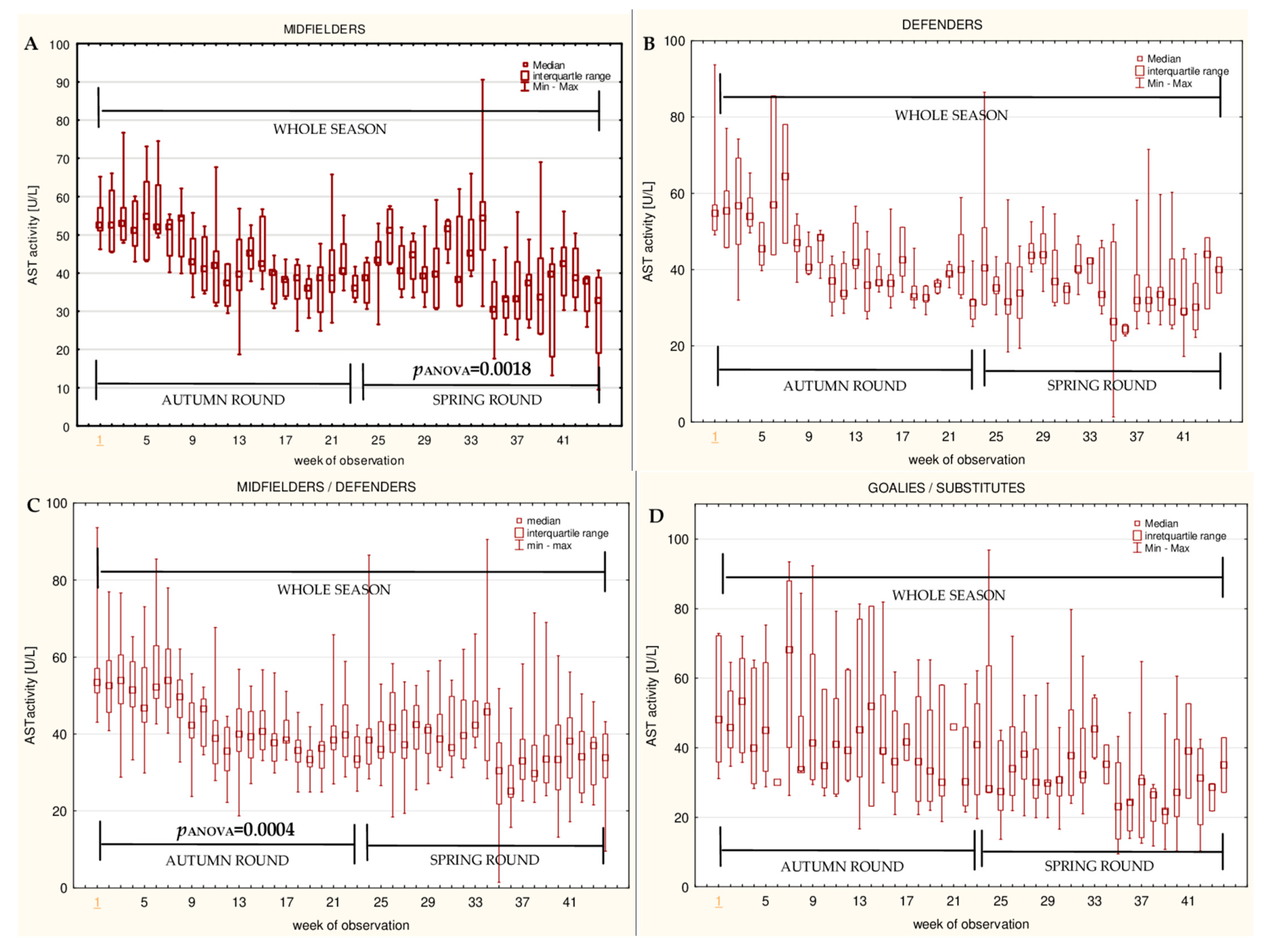
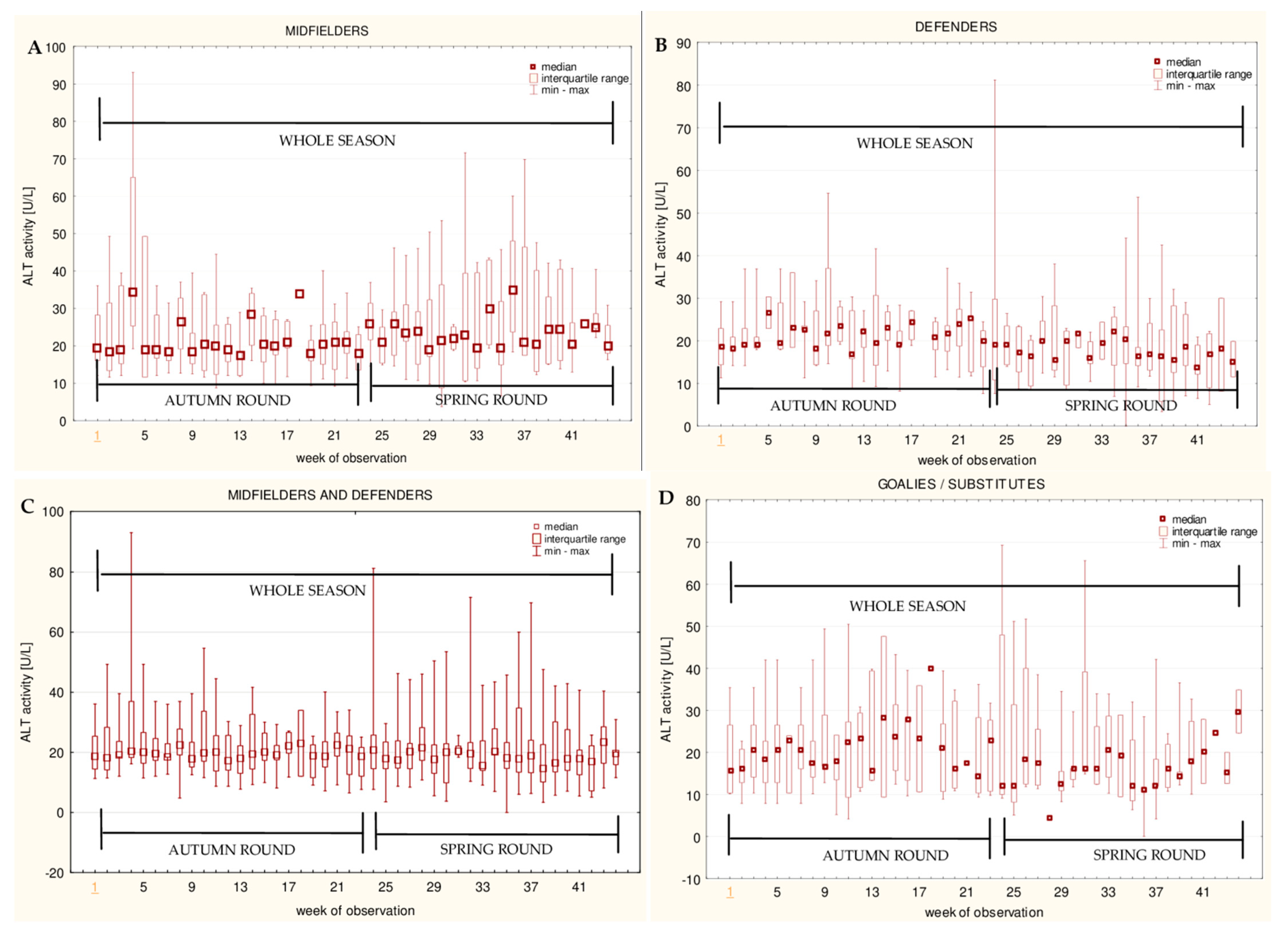
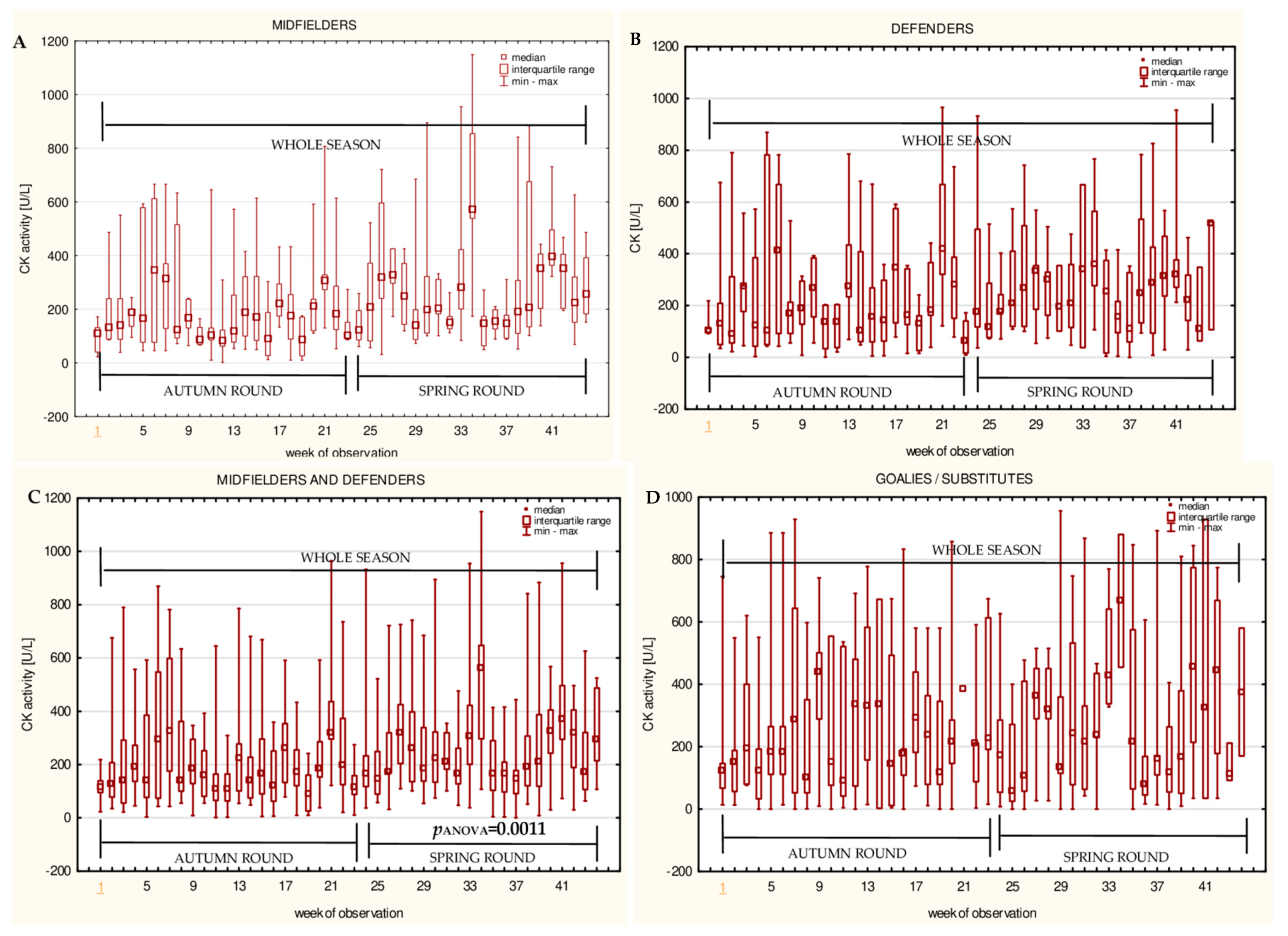

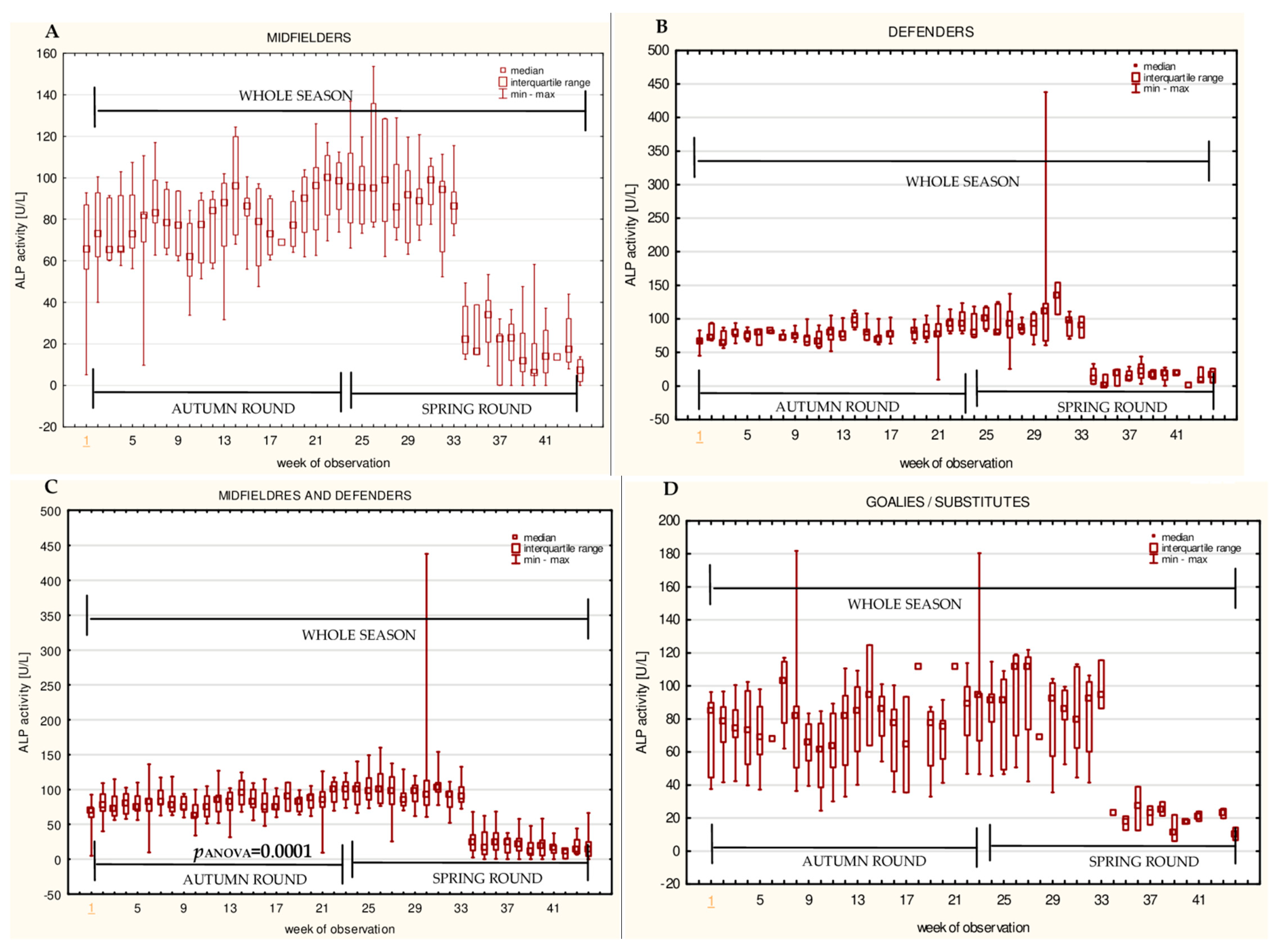
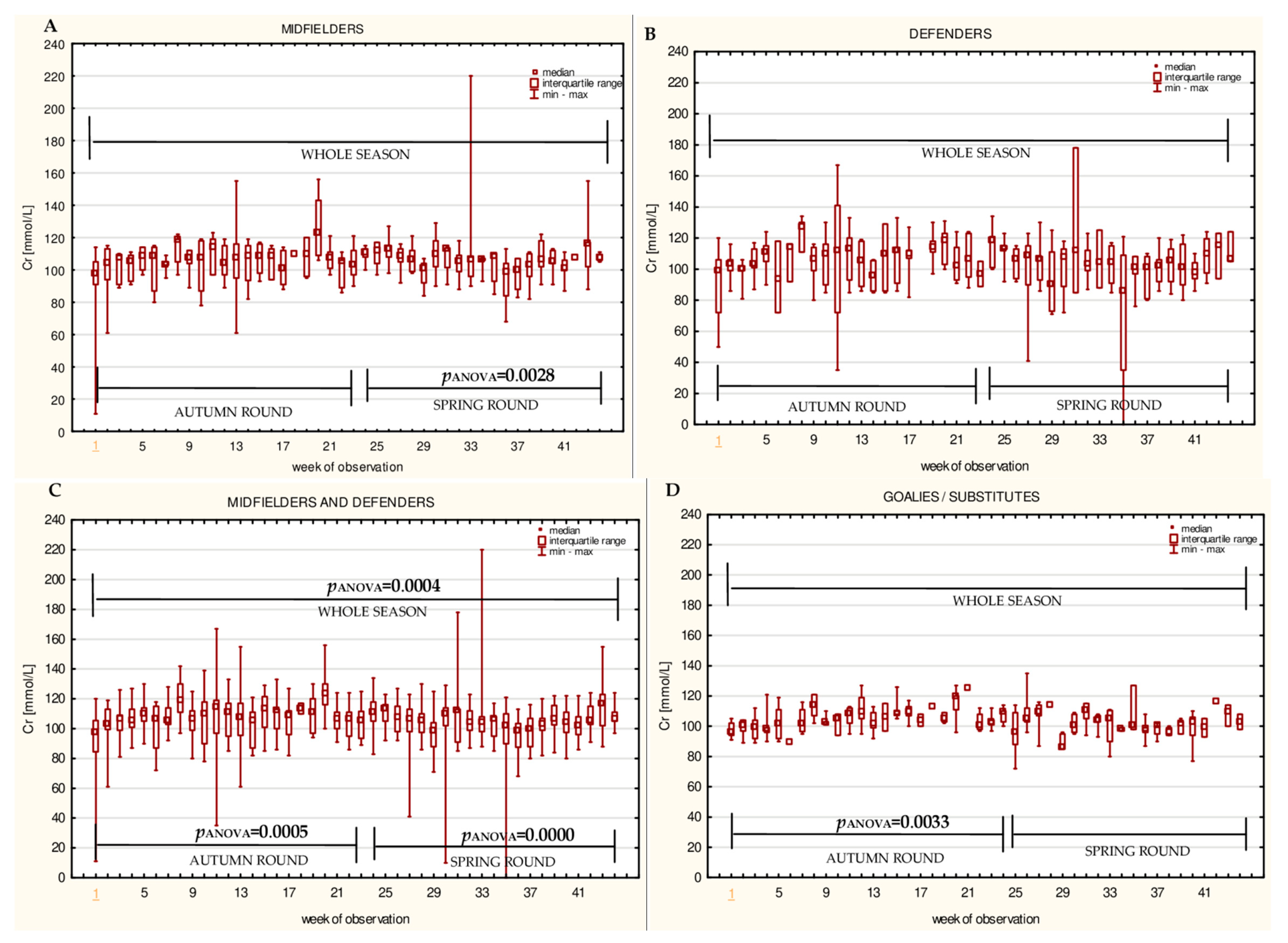
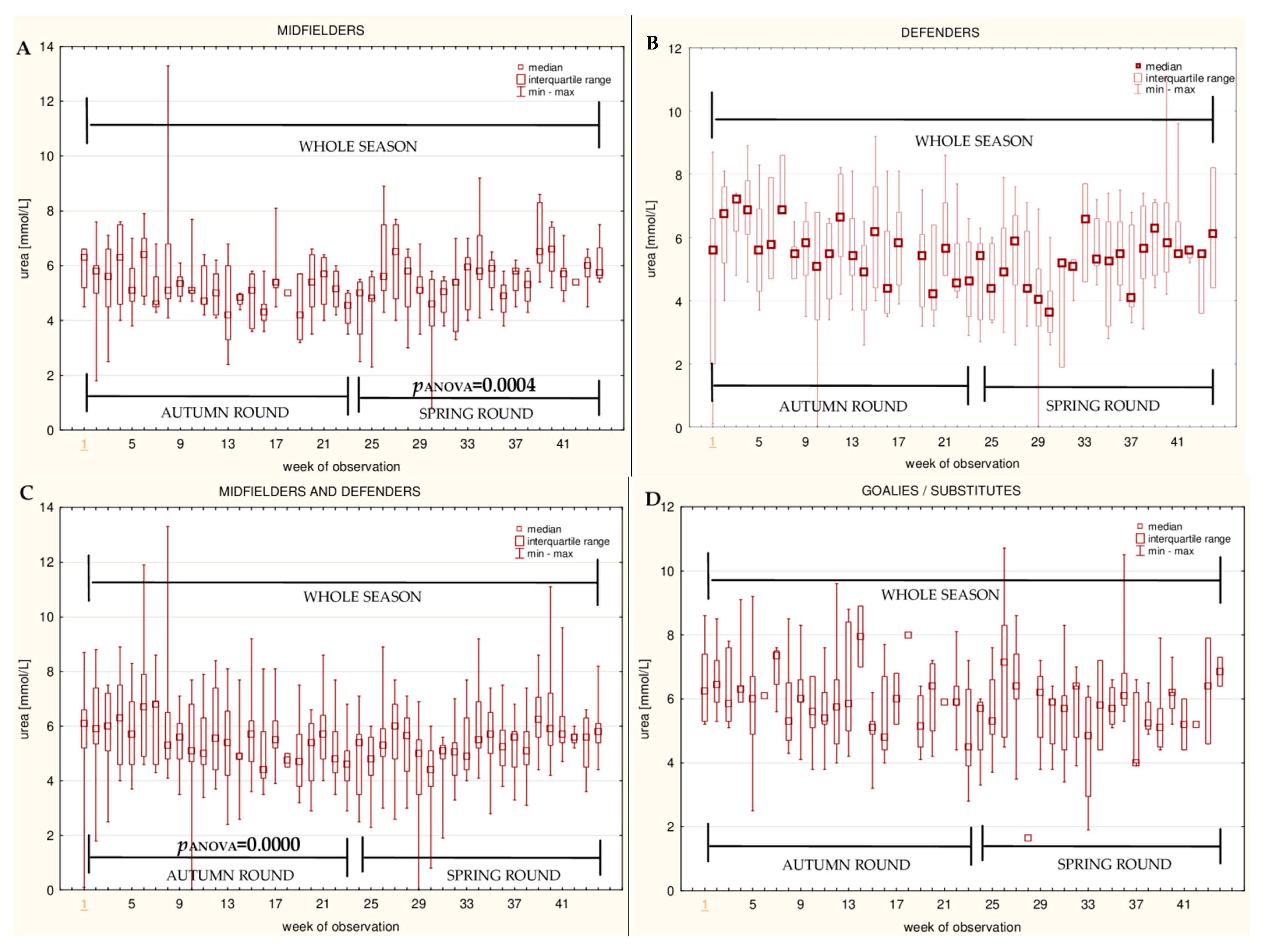
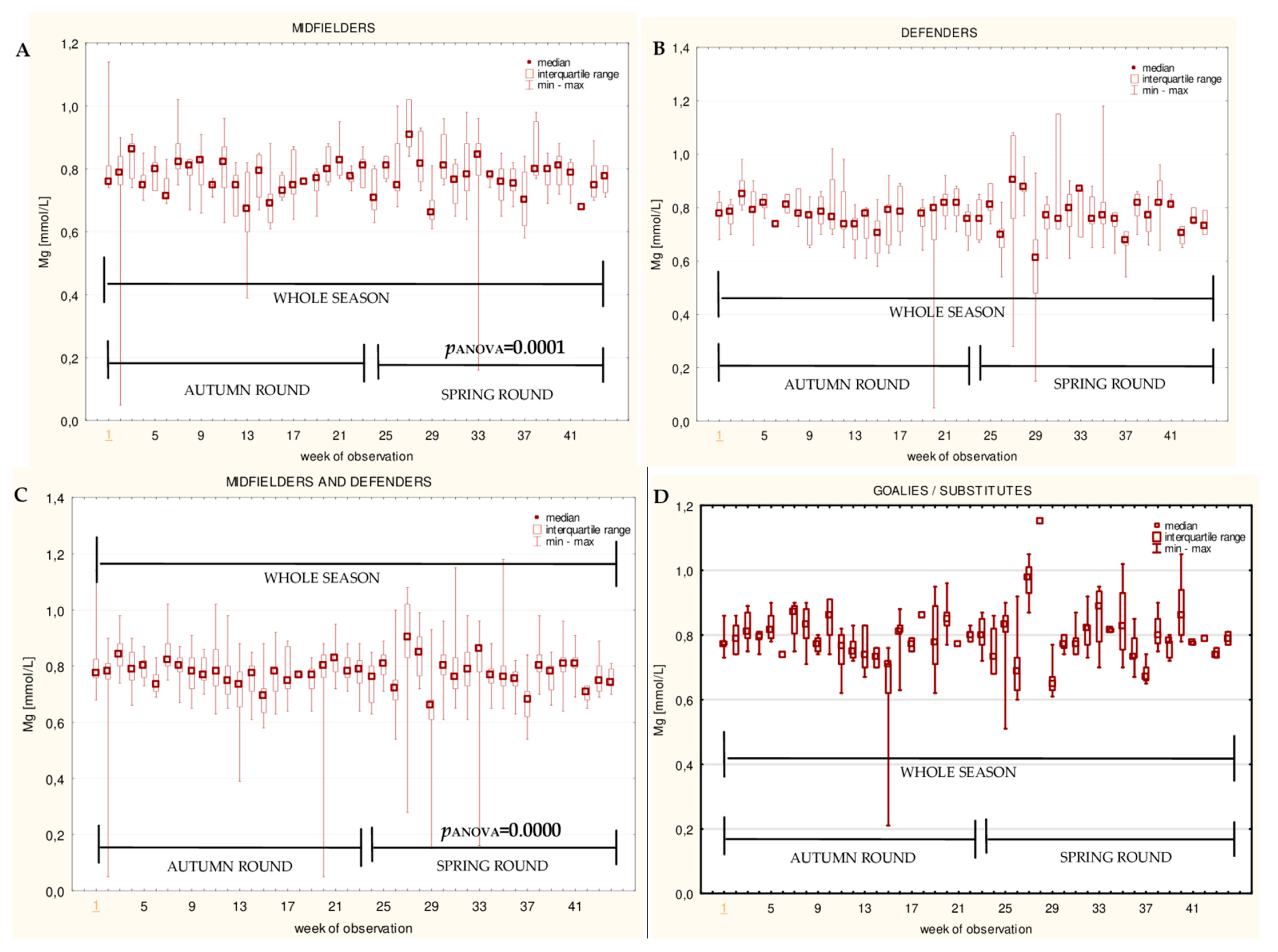
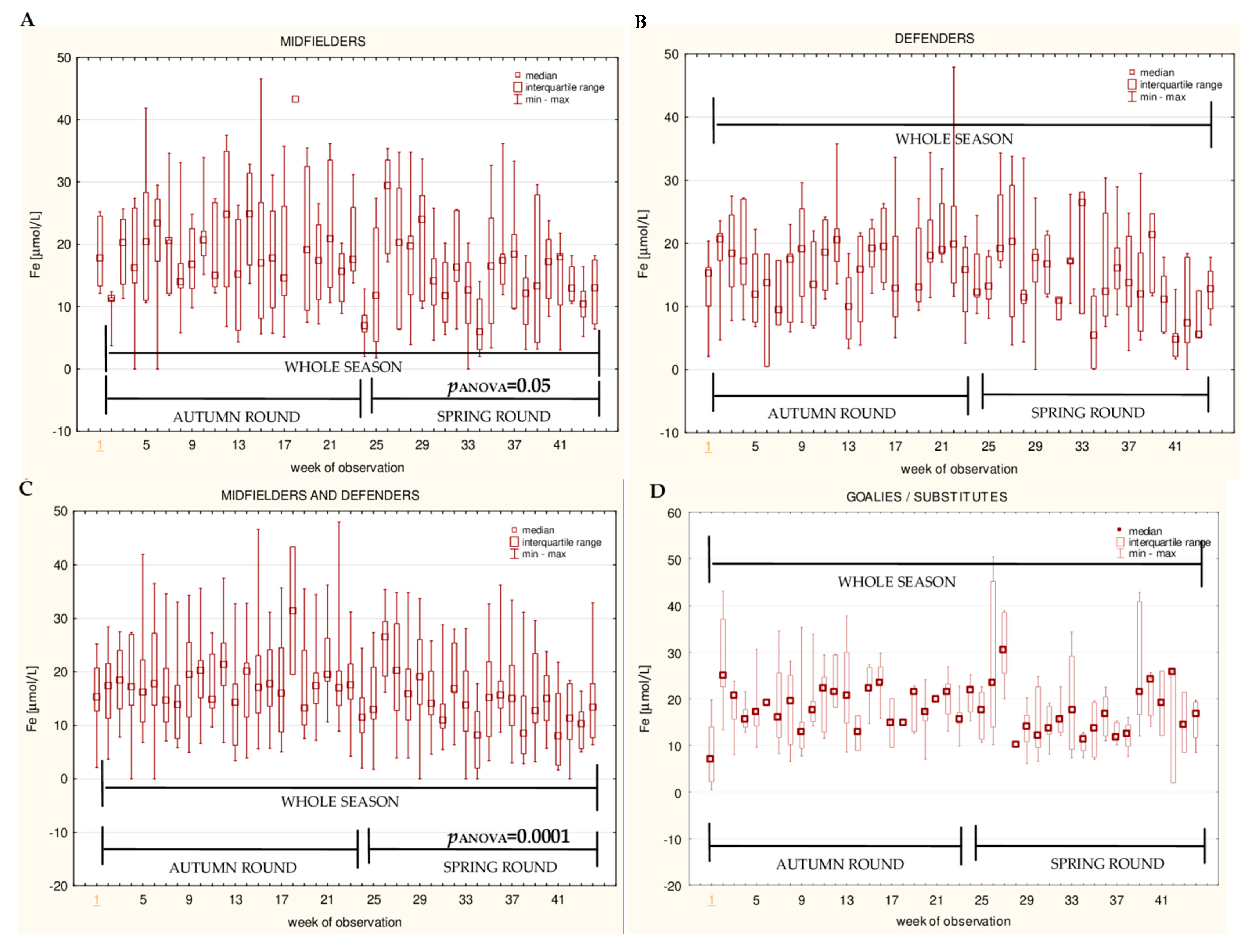
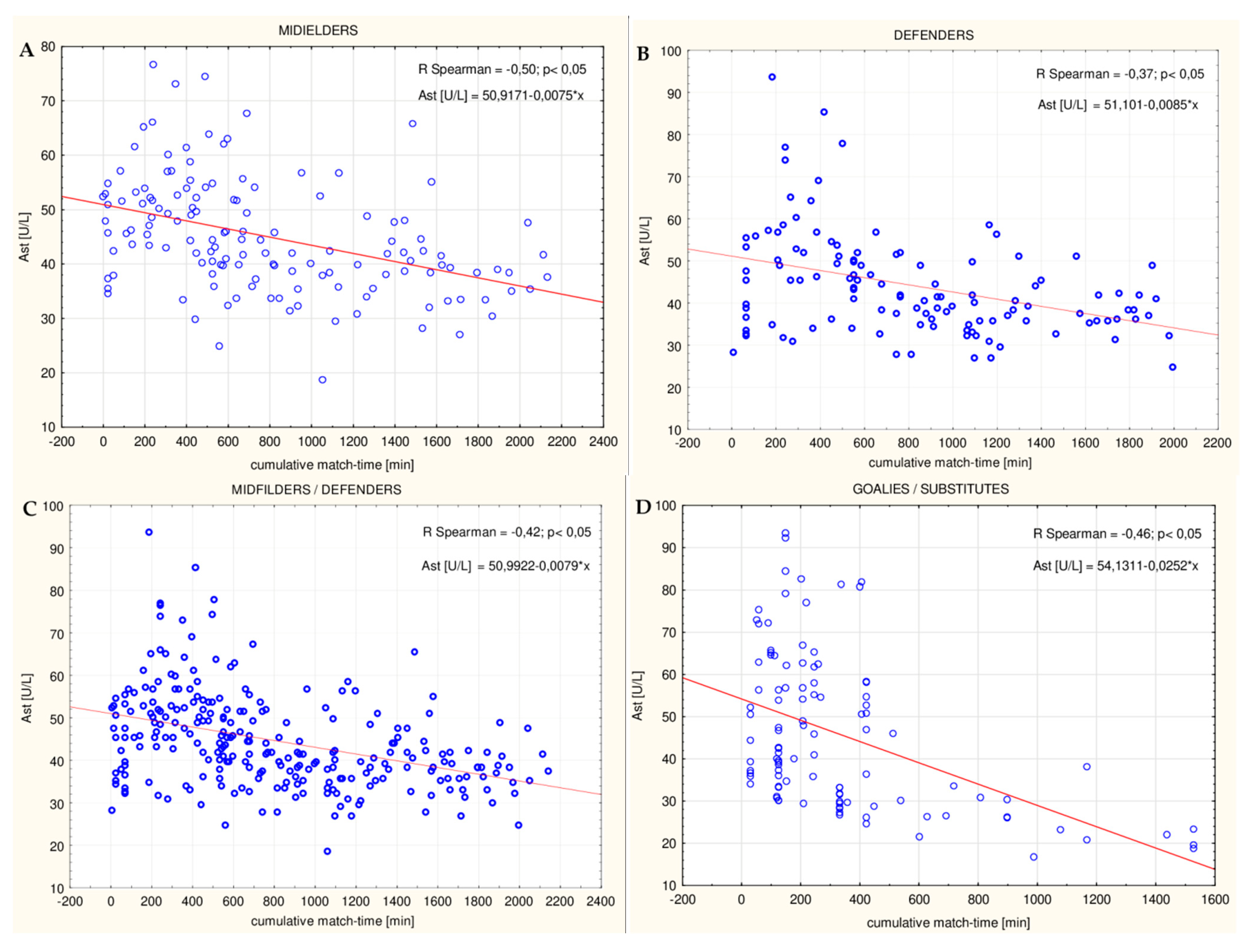
| Competitive Round | Blood Draws | Week’s Match-Time (min) | Cumulative Match-Time (min) |
|---|---|---|---|
| baseline | 0 | 0 | |
| Autumn round | 1st | 90 (82–90) | 90 (60–90) |
| 2nd | 58 (32–81) | 137 (76–170) | |
| 3th | 89 (6–90) | 206 (80–251) | |
| 4th | 90 (22–90) | 234 (80–339) | |
| 5th | 90 (53–90) | 283 (86–420) | |
| 6th | 90 (81–90) | 322 (118–480) | |
| 7th | 82 (45–90) | 377 (138–502) | |
| 8th | 90 (54–90) | 457 (138–564) | |
| 9th | 90 (17–90) | 502 (138–655) | |
| 10th | 80 (45–90) | 542 (138–710) | |
| 11th | 60 (25–90) | 561 (138–721) | |
| 12th | 90 (81–90) | 628 (167–811) | |
| 13th | 90 (78–90) | 675 (214–900) | |
| 14th | 31 (21–90) | 695 (215–931) | |
| 15th | 90 (84–90) | 724 (215–991) | |
| 16th | 90 (84–90) | 730 (245–1046) | |
| 17th | 90 (45–90) | 820 (275–1068) | |
| 18th | 34 (0–44) | 830 (275–1090) | |
| 19th | 90 (82–90) | 865 (275–1180) | |
| 20th | 90 (65–90) | 907 (285–1270) | |
| 21st | 90 (74–90) | 1047 (330–1367) | |
| 22nd | 90 (80–90) | 1076 (339–1399) | |
| 23th | 90 (74–90) | 1109 (384–1444) | |
| Spring round | 24th | 90 (80–90) | 1204(426–1572) |
| 25th | 90 (88–90) | 1293 (438–1576) | |
| 26th | 90 (89–90) | 1338 (426–1661) | |
| 27th | 90 (82–90) | 1348 (429–1751) | |
| 28th | 90 (8– 90) | 1364 (433–1777) | |
| 29th | 90 (64–90) | 1412 (433–1800) | |
| 30th | 90 (64–90) | 1453 (464–1890) | |
| 31st | 90 (60–90) | 1484 (464–1935) | |
| 32nd | 90 (0–90) | 1529 (464–1980) | |
| 33th | 90 (35–90) | 1570 (499–2070) | |
| 34th | 90 (0–90) | 1619(330–2071) | |
| 35th | 90 (64–90) | 1685 (536–2114) | |
| 36th | 90 (85–90) | 1741 (562–2204) | |
| 37th | 90 (88–90) | 1802 (607–2276) | |
| 38th | 90 (85–90) | 1866 (652–2334) | |
| 39th | 90 (71–90) | 1911 (697–2424) | |
| 40th | 90 (85–90) | 2001 (747–2514) | |
| 41st | 90 (51–90) | 2026 (792–2545) | |
| 42nd | 90 (0–90) | 2036 (792–2565) | |
| 43th | 25 (45–90) | 2041 (882–2575) | |
| 44th | 90 (61–90) | 2104 (923–2608) |
| Parameter | Midfielders | Defenders | Goalie/Substitute |
|---|---|---|---|
| n | 7 | 7 | 6 |
| Age (years) | 25 (21–30) * | 26 (21–30) * | 21 (19–25) * |
| Height (cm) | 179.0 (175–187) | 182.0 (181–185) | 188.5 (188–190) |
| Weight (kg) | 70.6 (68.3–80.7) | 77.0 (73.0–80.0) | 82 (78–87) |
| Length of training experience (years) | 16 (15–19) | 15 (12–18) | 14.5 (9.0–16.0) |
| The number of weekly training hours (h) | 13 (12–17.5) | 12 (10–17.5) | 12 (11–15) |
| Body Mass Index (kg/m2) | 22.4 (21.6–24.3) | 22.9 (22.5–24.2) | 23.1 (21.7–24.4) |
| Entire season match-time (min) | 2492 (1304–2680) | 2156 (989–2643) | 487.5 (366–2042) |
| Entire Season | Autumn Round | Spring Round | |||||||
|---|---|---|---|---|---|---|---|---|---|
| Midfielder/Defender | Goalie/Substitute | p | Midfielder/Defender | Goalie/Substitute | p | Midfielder/Defender | Goalie/Substitute | p | |
| AST (U/L) | 39.7 (33.4–47.7) | 36.15 (27.2–50.7) | 0.007 * | 42.0 (35.9–51.1) | 40.9 (30.3–58.0) | 0.753 | 36.6 (30.3–43.4) | 31.0 (24.9–42.4) | 0.003 * |
| ALT (U/L) | 19.4 (14.6–25.1) | 16.6 (11.9–26.8) | 0.026 * | 19.6 (16.0–25.1) | 17.7 (125–28.9) | 0.901 | 19.3 (14.4–25.0) | 15.5 (11.9–24.1) | 0.011 * |
| CK (U/L) | 177.6 (106.1–315.4) | 212.3 (85.9–454.8) | 0.175 | 161.0 (91.5–288.8) | 187.0 (73.6–479.9) | 0.546 | 205.6 (123.4–352.2) | 268.8 (114.4–454.6) | 0.314 |
| LDH (U/L) | 314.0 (233.0–386.0) | 348.8 (269.0–445.5) | 0.001 * | 296.0 (236.0–361.0) | 354.0 (264.0–443) | 0.001 * | 336.0 (196.0–401.0) | 358.0 (291.0–448.0) | 0.034 * |
| ALP (U/L) | 78.3 (62.7–94.9) | 77.2 (45.5–95.3) | 0.417 | 80.9 (68.9–93.6) | 77.8 (54.2–91.5) | 0.250 | 76.0 (20.6–97.7) | 70.0 (50.16–101.75) | 0.201 |
| Cr (mmol/L) | 107.0 (99.0–115.0) | 102.5 (96.5–109.0) | 0.001 * | 109.0 (98.5–116.0) | 104.0 (98.0–1100) | 0.016 * | 106.0 (99.0–113.0) | 100.0 (95.0–108.0) | 0.001 * |
| U (mmol/L) | 5.4 (4.5–6.3) | 5.7 (4.9–6.6) | 0.006 * | 5.4 (4.6–6.5) | 5.9 (5.1–6.8) | 0.003 * | 5.4 (4.5–6.2) | 5.4 (4.8–6.4) | 0.341 |
| Mg (mmol/L) | 0.78 (0.73–0.83) | 0.79 (0.74–0.83) | 0.133 | 0.78 (0.73–0.83) | 0.79 (0.75–0.83) | 0.086 | 0.78 (0.72–0.83) | 0.78 (0.73–0.83) | 0.583 |
| Fe (µmol/L) | 16.1 (10.8–21.5) | 17.4 (12.7–22.8) | 0.004 * | 17.3 (12.1–22.8) | 17.8 (14.2–23.3) | 0.188 | 13.8 (8.5–19.9) | 16.6 (12.0–22.5) | 0.003 * |
| Entire Season | Autumn Round | Spring Round | |||||||
|---|---|---|---|---|---|---|---|---|---|
| Midfielder | Defender | p | Midfielder | Defender | p | Midfielder | Defender | p | |
| AST (U/L) | 42.0 (35.4–49.4) | 39.0 (33.0–46.9) | 0.010 * | 43.4 (38.2–51.8) | 41.7 (35.8–50.3) | 0.144 | 39.6 (32.8–46.7) | 35.4 (29.2–43.4) | 0.023 * |
| ALT (U/L) | 21.3 (17.1–29.1) | 19.6 (14.6–24.1) | 0.001 * | 19.7 (16.1–26.2) | 21.8 (18.4–26.3) | 0.399 | 23.9 (17.5–31.9) | 18.2 (13.1–22.6) | 0.001 * |
| CK (U/L) | 174.8 (110.7–307.4) | 204.3 (100.5–358.4) | 0.392 | 145.0 (89.1–254.8) | 179.4 (79.8–331.4) | 0.343 | 206.8 (138.2–332.1) | 237.2 (109.3–380.8) | 0.827 |
| LDH (U/L) | 309.5 (228.0–379.0) | 322.0 (236.0–403.0) | 0.179 | 288.0 (233.0–346.0) | 300.0 (241.0–372.5) | 0.150 | 325.0 (223.0–397.0) | 349.0 (188.0–428.0) | 0.412 |
| ALP (U/L) | 78.1 (60.0–93.6) | 76.53 (63.3–90.3) | 0.645 | 82.0 (65.1–94.8) | 76.89 (68.6–85.7) | 0.481 | 76.1 (22.9–95.1) | 74.6 (19.3–101.9) | 0.849 |
| Cr (mmol/L) | 107.0 (99.0–112.0) | 106.0 (93.0–115.0) | 0.392 | 107.0 (97.0–114.0) | 107.0 (96.0–16.0) | 0.719 | 106.0 (100.0–111.0) | 104.0 (92.0–114.0) | 0.827 |
| U (mmol/L) | 5.4 (4.6–6.0) | 5.4 (4.4–6.6) | 0.595 | 5.1 (4.5–5.9) | 5.7 (4.5–8.8) | 0.029 * | 5.5 (4.8–6.2) | 5.2 (4.3–6.3) | 0.109 |
| Mg (mmol/L) | 0.78 (0.73–0.83) | 0.78 (0.72–0.83) | 0.754 | 0.77 (0.74–0.82) | 0.78 (0.73–0.83) | 0.586 | 0.79 (0.73–0.83) | 0.77 (0.71–0.84) | 0.379 |
| Fe (µmol/L) | 16.1 (11.0–22.5) | 15.6 (9.5–20.9) | 0.140 | 17.0 (12.9–24.8) | 17.3 (11.4–22.0) | 0.280 | 14.1 (8.4–20.2) | 12.6 (7.9–19.1) | 0.292 |
| Midfielder | Defender | Goalie/Substitute | |||||||
|---|---|---|---|---|---|---|---|---|---|
| Autumn Round | Spring Round | p | Autumn Round | Spring Round | p | Autumn Round | Spring Round | p | |
| AST (U/L) | 43.4 (38.2–51.8) | 39.6 (32.8–46.7) | 0.0003 * | 41.7 (35.8–50.3) | 35.4 (29.2–43.4) | 0.0000 * | 40.9 (30.3–58.0) | 31.0 (24.9–42.4) | 0.0000 * |
| ALT (U/L) | 19.7 (16.1–26.2) | 23.9 (17.5–31.9) | 0.009 * | 21.8 (18.4–26.3) | 18.2 (13.1–22.6) | 0.0005 * | 17.7 (125–28.9) | 15.5 (11.9–24.1) | 0.1688 |
| CK (U/L) | 145.0 (89.1–254.8) | 206.8 (138.2–332.1) | 0.0002 * | 179.4 (79.8–331.4) | 237.2 (109.3–380.8) | 0.0743 | 187.0 (73.6–479.9) | 268.8 (114.4–454.6) | 0.4669 |
| LDH (U/L) | 288.0 (233.0–346.0) | 325.0 (223.0–397.0) | 0.1156 | 300.0 (241.0–372.5) | 349.0 (188.0–428.0) | 0.6596 | 354.0 (264.0–443) | 358.0 (291.0–448.0) | 0.4246 |
| ALP (U/L) | 82.0 (65.1–94.8) | 76.1 (22.9–95.1) | 0.8662 | 76.89 (68.6–85.7) | 74.6 (19.3–101.9) | 0.0675 | 77.8 (54.2–91.5) | 70.0 (50.16–101.75) | 0.7366 |
| Cr (mmol/L) | 107.0 (97.0–114.0) | 106.0 (100.0–111.0) | 0.4758 | 107.0 (96.0–116.0) | 104.0 (92.0–114.0) | 0.1761 | 104.0 (98.0–1100) | 100.0 (95.0–108.0) | 0.0745 |
| U (mmol/L) | 5.1 (4.5–5.9) | 5.5 (4.8–6.2) | 0.03 * | 5.7 (4.5–8.8) | 5.2 (4.3–6.3) | 0.0514 | 5.9 (5.1–6.8) | 5.4 (4.8–6.4) | 0.2619 |
| Mg (mmol/L) | 0.77 (0.74–0.82) | 0.79 (0.73–0.83) | 0.004 * | 0.78 (0.73–0.83) | 0.77 (0.71–0.84) | 0.6596 | 0.79 (0.75–0.83) | 0.78 (0.73–0.83) | 0.4689 |
| Fe (µmol/L) | 17.0 (12.9–24.8) | 14.1 (8.4–20.2) | 0.0002 * | 17.3 (11.4–22.0) | 12.6 (7.9–19.1) | 0.0049* | 17.8 (14.2–23.3) | 16.6 (12.0–22.5) | 0.1554 |
© 2019 by the authors. Licensee MDPI, Basel, Switzerland. This article is an open access article distributed under the terms and conditions of the Creative Commons Attribution (CC BY) license (http://creativecommons.org/licenses/by/4.0/).
Share and Cite
Nowakowska, A.; Kostrzewa-Nowak, D.; Buryta, R.; Nowak, R. Blood Biomarkers of Recovery Efficiency in Soccer Players. Int. J. Environ. Res. Public Health 2019, 16, 3279. https://doi.org/10.3390/ijerph16183279
Nowakowska A, Kostrzewa-Nowak D, Buryta R, Nowak R. Blood Biomarkers of Recovery Efficiency in Soccer Players. International Journal of Environmental Research and Public Health. 2019; 16(18):3279. https://doi.org/10.3390/ijerph16183279
Chicago/Turabian StyleNowakowska, Anna, Dorota Kostrzewa-Nowak, Rafał Buryta, and Robert Nowak. 2019. "Blood Biomarkers of Recovery Efficiency in Soccer Players" International Journal of Environmental Research and Public Health 16, no. 18: 3279. https://doi.org/10.3390/ijerph16183279
APA StyleNowakowska, A., Kostrzewa-Nowak, D., Buryta, R., & Nowak, R. (2019). Blood Biomarkers of Recovery Efficiency in Soccer Players. International Journal of Environmental Research and Public Health, 16(18), 3279. https://doi.org/10.3390/ijerph16183279







